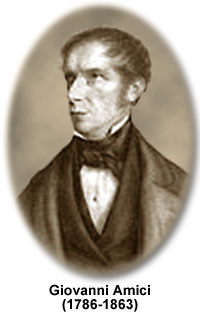Giovanni Battista Amici
(1786-1863)

Giovanni Amici was an Italian microscopist, astronomer, optical instrument designer, and botanist, who is best known as the achromatic lens inventor, also designed reflecting telescopes and introduced a lens for the inspection of an objective's rear focal plane, termed the Amici-Bertrand lens. In 1850, he also invented the water immersion lens.
Born in the Duchy of Modena, Amici received an 1807 diploma in engineering and architecture from the University of Bologna. He was a professor of mathematics at the University of Modena (1815-1825) and then chief astronomer to the Grand Duke of Tuscany. Amici was also the director of the observatory and professor of astronomy at Royal Museum in Florence. By 1859, he was responsible for reporting microscopic observations to the Museum of Physics and Natural History where he published a wide variety of papers. Minor planet (3809) Amici is named in his honor, as is a crater on the dark side of the Moon.
In 1840, Amici introduced the oil-immersion technique to microscopy that minimizes optical aberrations, followed by the water-immersion objective (1855). Many innovations by this nineteenth century Italian designer have led important developments in the modern microscope, including a compound "periscope" instrument (1833) that moved microscopic viewing from the horizontal to vertical position, and a series of horizontal compound achromatic microscopes (circa 1850). One achromatic microscope had a quad-observation tube that allowed four individuals to simultaneously observe the specimen. The Amici prism, a combination of three prisms, is still used in refracting spectroscopy.
In astronomy, Amici studied double stars, Jupiter's moons and designed improvements to reflecting telescope mirrors including grinding several 10-inch and 12-inch metal mirrors. With his own micrometer design, Amici made accurate measurements of the polar and equatorial diameters of the Sun. Combining botany interests with innovative advances in compound microscopes, the Italian scientist made important discoveries about the circulation of sap in plants and the processes of plant reproduction, including many details of orchid pollination and seed development.
